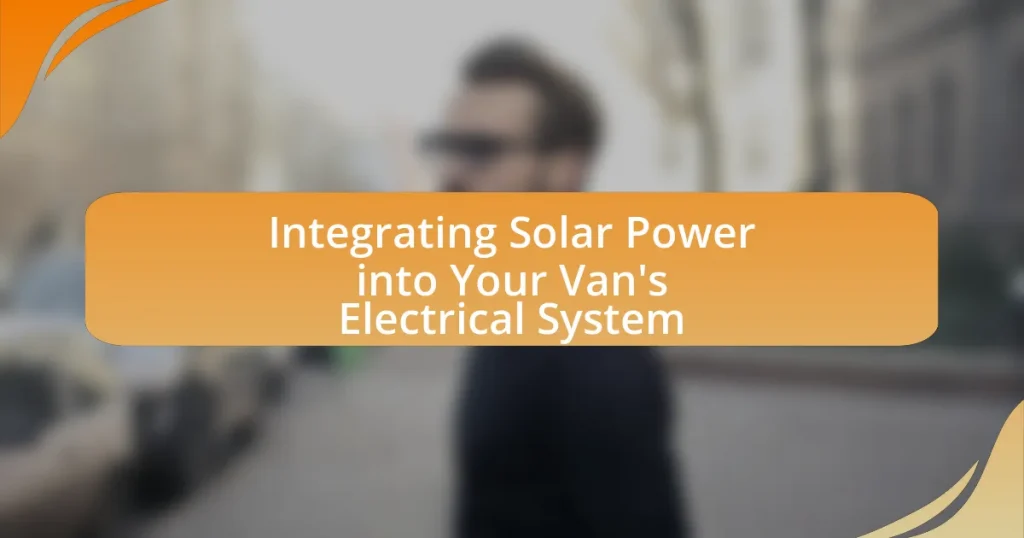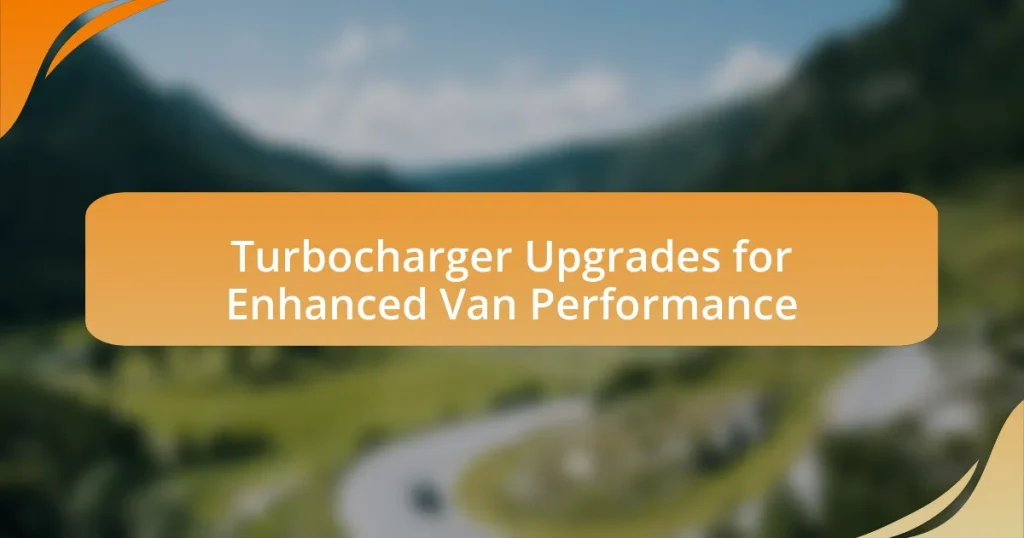Integrating solar power into a van’s electrical system involves the installation of solar panels, a charge controller, and a battery bank to harness and store solar energy for off-grid power generation. This setup allows van owners to operate appliances and devices independently from external power sources, enhancing energy efficiency and sustainability. The article outlines the essential components of a solar power system, the process of installation, and the advantages of solar integration, including energy independence and cost savings. Additionally, it addresses common challenges, maintenance practices, and best practices for optimizing solar energy usage in a van.
What is Integrating Solar Power into Your Van’s Electrical System?
Integrating solar power into your van’s electrical system involves installing solar panels, a charge controller, and a battery bank to harness and store solar energy for use in the van. This setup allows for off-grid power generation, enabling the operation of appliances and devices without relying on external power sources. The solar panels convert sunlight into electricity, which is regulated by the charge controller to prevent battery overcharging. The stored energy in the battery bank can then be used to power various electrical systems within the van, providing a sustainable and renewable energy solution for van life.
How does solar power integration work in a van?
Solar power integration in a van involves installing solar panels on the roof, which capture sunlight and convert it into electricity. This electricity is then routed through a charge controller to a battery bank, where it is stored for later use. The stored energy can power various electrical devices within the van, such as lights, appliances, and charging ports. The efficiency of this system is enhanced by using high-quality solar panels and batteries, which can significantly extend the van’s off-grid capabilities.
What are the essential components of a solar power system in a van?
The essential components of a solar power system in a van include solar panels, a charge controller, batteries, an inverter, and wiring. Solar panels convert sunlight into electricity, while the charge controller regulates the voltage and current coming from the panels to prevent battery overcharging. Batteries store the generated electricity for later use, and the inverter converts the stored DC power into AC power for household appliances. Proper wiring connects all these components, ensuring efficient energy flow throughout the system.
How do solar panels convert sunlight into electricity for van use?
Solar panels convert sunlight into electricity for van use through the photovoltaic effect. When sunlight hits the solar cells in the panels, it excites electrons, creating an electric current. This process involves semiconductor materials, typically silicon, which absorb photons from sunlight and release electrons. The movement of these electrons generates direct current (DC) electricity.
To utilize this electricity in a van, the DC output is often routed through a charge controller to manage battery charging, ensuring that the batteries store energy efficiently without overcharging. This stored energy can then power various electrical devices within the van, such as lights, appliances, and charging ports. The efficiency of solar panels can vary, with typical conversion rates ranging from 15% to 22%, depending on the technology used.
What are the advantages of integrating solar power into a van’s electrical system?
Integrating solar power into a van’s electrical system provides significant advantages, including energy independence, reduced fuel costs, and environmental benefits. By harnessing solar energy, van owners can generate their own electricity, allowing them to power appliances and devices without relying on external sources or running a generator. This leads to lower operational costs, as solar energy is free once the initial investment in solar panels and equipment is made. Additionally, using solar power reduces carbon emissions, contributing to a more sustainable lifestyle. According to the U.S. Department of Energy, solar energy systems can reduce greenhouse gas emissions by displacing fossil fuel use, further validating the environmental benefits of this integration.
How does solar power enhance energy independence while traveling?
Solar power enhances energy independence while traveling by allowing individuals to generate their own electricity, reducing reliance on external power sources. This self-sufficiency is particularly beneficial for travelers in remote areas where access to traditional power grids is limited. For instance, solar panels can charge batteries that power appliances and devices, enabling continuous energy supply without needing to find a charging station. According to the U.S. Department of Energy, solar energy systems can significantly lower energy costs and provide a reliable power source, making them ideal for those on the move.
What cost savings can be achieved through solar power integration?
Solar power integration can achieve significant cost savings by reducing electricity bills and minimizing reliance on fossil fuels. By generating electricity from sunlight, users can offset their energy consumption, leading to lower monthly utility costs. For instance, a study by the National Renewable Energy Laboratory found that residential solar installations can save homeowners an average of $10,000 to $30,000 over 20 years, depending on local energy prices and incentives. Additionally, solar power can provide long-term savings by protecting users from rising energy costs, as solar energy is free once the system is installed.
What are the steps to integrate solar power into your van’s electrical system?
To integrate solar power into your van’s electrical system, follow these steps: First, assess your power needs by calculating the total wattage of devices you plan to use. Next, select appropriate solar panels based on your power requirements and available roof space. After that, install the solar panels securely on the roof of your van, ensuring they are angled for optimal sunlight exposure. Then, connect the solar panels to a charge controller, which regulates the voltage and current going to the battery. Following this, connect the charge controller to a deep-cycle battery to store the solar energy. Finally, wire the battery to your van’s electrical system, ensuring all connections are secure and properly insulated. This process allows for efficient use of solar energy, reducing reliance on traditional power sources.
How do you assess your energy needs for solar power integration?
To assess energy needs for solar power integration, calculate the total watt-hours required by all electrical devices in the van. This involves listing each device, noting its wattage, and estimating daily usage in hours. For example, if a refrigerator uses 100 watts and runs for 8 hours, it consumes 800 watt-hours daily. Summing the watt-hours of all devices provides the total energy requirement. This method is validated by the National Renewable Energy Laboratory, which emphasizes the importance of accurate energy consumption estimates for effective solar system design.
What factors should be considered when calculating energy consumption in a van?
When calculating energy consumption in a van, factors such as the total wattage of electrical appliances, the duration of their use, the efficiency of the energy system, and the van’s insulation and temperature control must be considered. The total wattage includes all devices like lights, refrigerators, and electronics, which collectively determine the energy demand. The duration of use affects how long these devices draw power, directly influencing overall consumption. The efficiency of the energy system, including the inverter and battery performance, impacts how much energy is effectively utilized versus wasted. Additionally, insulation and temperature control can affect energy needs for heating or cooling, thereby altering consumption levels. These factors collectively provide a comprehensive understanding of energy requirements for effective solar power integration into a van’s electrical system.
How can you determine the appropriate size of the solar power system?
To determine the appropriate size of a solar power system, calculate your daily energy consumption in watt-hours and divide that by the average solar insolation hours in your location. For instance, if your van requires 1,200 watt-hours per day and you receive an average of 5 hours of sunlight, you would need a solar system rated at 240 watts (1,200 watt-hours / 5 hours = 240 watts). This calculation ensures that the solar power system can meet your energy needs effectively, taking into account factors such as system efficiency and potential energy losses.
What installation steps are involved in integrating solar power?
The installation steps involved in integrating solar power include assessing energy needs, selecting appropriate solar panels and components, installing the solar panels on the roof, connecting the panels to a charge controller, wiring the charge controller to the battery bank, and finally connecting the battery bank to the van’s electrical system. Each step is crucial for ensuring that the solar power system operates efficiently and meets the energy demands of the van. For instance, selecting the right solar panel size is essential to match the energy consumption, while proper wiring ensures safety and functionality.
How do you install solar panels on your van’s roof?
To install solar panels on your van’s roof, first, select the appropriate solar panel size and type based on your energy needs and roof space. Next, clean the roof surface thoroughly to ensure proper adhesion. Then, use mounting brackets or adhesive to secure the solar panels to the roof, ensuring they are positioned to maximize sun exposure. After securing the panels, connect the wiring from the solar panels to a charge controller, which regulates the power going to your battery system. Finally, connect the charge controller to your battery bank to complete the installation. This method is effective as it allows for efficient energy capture and storage, essential for van life.
What wiring and connections are necessary for a complete solar setup?
A complete solar setup requires solar panels, a charge controller, batteries, an inverter, and appropriate wiring and connections. The solar panels convert sunlight into electricity, which is then regulated by the charge controller to prevent overcharging the batteries. The batteries store the energy for later use, while the inverter converts the stored DC power into AC power for household appliances.
For wiring, use solar-rated cables to connect the panels to the charge controller and the charge controller to the batteries. Additionally, use appropriate gauge wires to connect the batteries to the inverter, ensuring they can handle the current load. Connect the inverter to the electrical system of the van to power devices. Proper fusing and circuit breakers should also be included to protect the system from overloads and short circuits.
What are the common challenges and solutions in integrating solar power into a van’s electrical system?
Common challenges in integrating solar power into a van’s electrical system include limited roof space for solar panels, inefficient energy storage, and compatibility issues with existing electrical components. Solutions to these challenges involve optimizing panel placement to maximize sunlight exposure, using high-capacity lithium batteries for better energy storage, and ensuring that the solar charge controller is compatible with the van’s electrical system. For instance, a study by the National Renewable Energy Laboratory indicates that optimizing solar panel orientation can increase energy capture by up to 25%, demonstrating the importance of effective installation strategies.
What issues might arise during the installation of solar power systems?
Issues that might arise during the installation of solar power systems include improper sizing of components, inadequate mounting, and electrical connection problems. Improper sizing can lead to insufficient power generation or system overload, as evidenced by studies indicating that mismatched inverter and panel capacities can reduce efficiency by up to 30%. Inadequate mounting may result in physical damage or reduced performance due to shading, which can decrease energy output significantly. Electrical connection problems, such as loose or corroded connections, can lead to system failures or safety hazards, with reports showing that poor connections are a common cause of solar system malfunctions.
How can you troubleshoot common installation problems?
To troubleshoot common installation problems when integrating solar power into your van’s electrical system, first check all connections to ensure they are secure and correctly wired. Loose or incorrect connections can lead to system failures or inefficiencies. Next, verify that the solar panels are receiving adequate sunlight; obstructions or dirt can significantly reduce their output. Additionally, inspect the charge controller settings to confirm they match the specifications of your battery type, as incorrect settings can prevent proper charging. Finally, use a multimeter to test voltage levels at various points in the system, which can help identify issues such as faulty components or wiring problems. These steps are essential for diagnosing and resolving installation issues effectively.
What maintenance practices are essential for a solar power system in a van?
Essential maintenance practices for a solar power system in a van include regular cleaning of solar panels, checking connections and wiring, monitoring battery health, and ensuring proper ventilation. Cleaning solar panels removes dirt and debris that can reduce efficiency, while checking connections and wiring prevents potential electrical issues. Monitoring battery health involves checking charge levels and ensuring batteries are not over-discharged, which can extend their lifespan. Proper ventilation prevents overheating of components, ensuring optimal performance. These practices are crucial for maintaining the efficiency and longevity of the solar power system.
How can you optimize the performance of your solar power system?
To optimize the performance of your solar power system, ensure proper panel orientation and tilt to maximize sunlight exposure. Solar panels should ideally face true south in the Northern Hemisphere or true north in the Southern Hemisphere, with an angle that corresponds to your latitude for optimal energy capture. Additionally, regular cleaning of the panels is essential, as dirt and debris can reduce efficiency by up to 25%. Implementing a solar charge controller can also enhance performance by preventing overcharging and optimizing battery usage. According to the U.S. Department of Energy, maintaining optimal conditions can increase solar energy production significantly, ensuring that your system operates at peak efficiency.
What tips can help maximize solar energy efficiency in a van?
To maximize solar energy efficiency in a van, install high-efficiency solar panels that convert more sunlight into electricity. High-efficiency panels, such as monocrystalline solar panels, can achieve efficiencies of over 20%, allowing for more power generation in limited space. Additionally, ensure optimal panel placement by positioning them at an angle that captures maximum sunlight throughout the day, typically between 30 to 45 degrees depending on your geographic location.
Using a solar charge controller is crucial, as it regulates the voltage and current coming from the solar panels to prevent battery overcharging, thus extending battery life and efficiency. Regularly cleaning the solar panels to remove dirt and debris can also enhance their performance, as even a small amount of obstruction can significantly reduce energy output.
Finally, incorporating energy-efficient appliances and LED lighting in the van reduces overall energy consumption, allowing the solar system to meet power needs more effectively. These strategies collectively contribute to maximizing solar energy efficiency in a van.
How can you monitor and manage your solar power usage effectively?
To monitor and manage your solar power usage effectively, utilize a solar monitoring system that tracks energy production and consumption in real-time. These systems often include features such as mobile apps or web interfaces that provide data on solar panel output, battery status, and energy usage patterns. For instance, devices like the Victron Energy Color Control GX or the Renogy Solar Monitoring App allow users to analyze their solar energy performance, helping to optimize usage and identify inefficiencies. Studies show that real-time monitoring can increase energy savings by up to 30% by enabling users to adjust their consumption based on solar generation levels.
What are the best practices for integrating solar power into your van’s electrical system?
The best practices for integrating solar power into your van’s electrical system include selecting the appropriate solar panel size, using a quality charge controller, and ensuring proper battery storage. Choosing solar panels that match your energy needs is crucial; for example, a 200W panel typically provides sufficient power for basic appliances. A quality charge controller, such as a MPPT (Maximum Power Point Tracking) type, optimizes energy transfer and protects the battery from overcharging. Additionally, using deep-cycle batteries, like lithium or AGM, ensures reliable energy storage and longevity, as they can handle frequent charging and discharging cycles effectively. These practices enhance the efficiency and reliability of the solar power system in a van.



